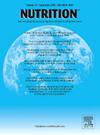静息代谢率在稳定状态的早期、中期和晚期成就者之间的低变异性表明,幼儿的间接量热法方案缩短了
IF 3.2
3区 医学
Q2 NUTRITION & DIETETICS
引用次数: 0
摘要
目的静息代谢率(RMR)测量标准化方案;kJ/d),使用间接量热法(IC),是缺乏的。在这项横断面观察性研究中,我们旨在确定,在不同的儿童群体中,rmr相关测量在使用缩短的IC方案达到稳态(SS)后的变异性。通过IC (Quark RMR, Cosmed)测量了120名方便抽样的6至9岁的南非健康儿童(60名黑人[32名女孩],60名白人[37名女孩])的RMR。方法在不休息的情况下,持续测量15 ~ 20分钟。参与者根据完成机器生成的SS的时间进行分类:早期成就者5分钟,中等成就者≥5分钟,晚期成就者≥10分钟。在达到SS之前的读数被删除。在剩余的测量期内,测定每个SS类别的平均RMR (kJ/d)、VCO2 (mL/min)、VO2 (mL/min)和呼吸商(VCO2/VO2)的个体内百分比变异系数。结果113例(94%)参与者获得了可用的数据。意思是(最小值;最大)达到SS的时间为5.7分钟(0.0;16.2)。19 (17%;6黑色;10名女生[3名黑人]未达到SS,性别差异无统计学意义(P = 0.290)。白人(12%)高于黑人(5%)。早期成就者47人(50%),中等成就者29人(31%),晚期成就者18人(19%)。性别(P = 0.955)和种族/民族类别(P = 9.758)之间的SS类别样本分布无显著差异。结论:达到SS后,所有rmr相关变量的变异百分率系数仍≤2.89%,远低于成人推荐的5% ~ 10%。缩短IC方案可以考虑不同群体的6至9岁儿童。本文章由计算机程序翻译,如有差异,请以英文原文为准。
Low variability of resting metabolic rate among early, middle, and late achievers of steady state suggests a shortened indirect calorimetry protocol for young children
Objective
Standardized protocols for measuring resting metabolic rate (RMR; kJ/d) in children, using indirect calorimetry (IC), are lacking. In this cross-sectional, observational study we aimed to determine, in a diverse group of children, variability of RMR-associated measurements after achieving steady state (SS) with a shortened IC protocol. RMR of 120 conveniently sampled healthy Southern African children 6 to 9 years (60 black [32 girls], 60 white [37 girls]) was measured via IC (Quark RMR, Cosmed).
Methods
Measurements, without a prior rest period, continued for 15 to 20 minutes. Participants were categorized according to time when machine-generated SS was achieved: early achievers <5 minutes, middle achievers ≥5 and <10 minutes, late achievers ≥10 minutes. Readings before achieving SS were eliminated. Intra-individual percentage coefficient of variation of the mean RMR (kJ/d), VCO2 (mL/min), VO2 (mL/min), and respiratory quotient (VCO2/VO2) was determined for each SS category for the remaining measurement period.
Results
For 113 (94%) participants, usable data were obtained. Mean (min; max) time to reach SS was 5.7 minutes (0.0; 16.2). Nineteen (17%; 6 black; 10 girls [3 black]) did not achieve SS, with no significant difference between sexes (P = 0.290). Significantly (P = 0.048) more white (12%) than black (5%) participants did not achieve SS. Forty-seven (50%) were early, 29 (31%) middle, and 18 (19%) late achievers of SS. There was no significant difference in the sample distribution of SS categories between sexes (P = 0.955) and race/ethnicity categories (P = 9.758).
Conclusions
After achieving SS, percentage coefficient of variation for all RMR-related variables remained ≤2.89%, well below the recommended <5% to 10% for adults. A shortened IC protocol can be considered for diverse groups of 6- to 9-year-old children.
求助全文
通过发布文献求助,成功后即可免费获取论文全文。
去求助
来源期刊

Nutrition
医学-营养学
CiteScore
7.80
自引率
2.30%
发文量
300
审稿时长
60 days
期刊介绍:
Nutrition has an open access mirror journal Nutrition: X, sharing the same aims and scope, editorial team, submission system and rigorous peer review.
Founded by Michael M. Meguid in the early 1980''s, Nutrition presents advances in nutrition research and science, informs its readers on new and advancing technologies and data in clinical nutrition practice, encourages the application of outcomes research and meta-analyses to problems in patient-related nutrition; and seeks to help clarify and set the research, policy and practice agenda for nutrition science to enhance human well-being in the years ahead.
 求助内容:
求助内容: 应助结果提醒方式:
应助结果提醒方式:


